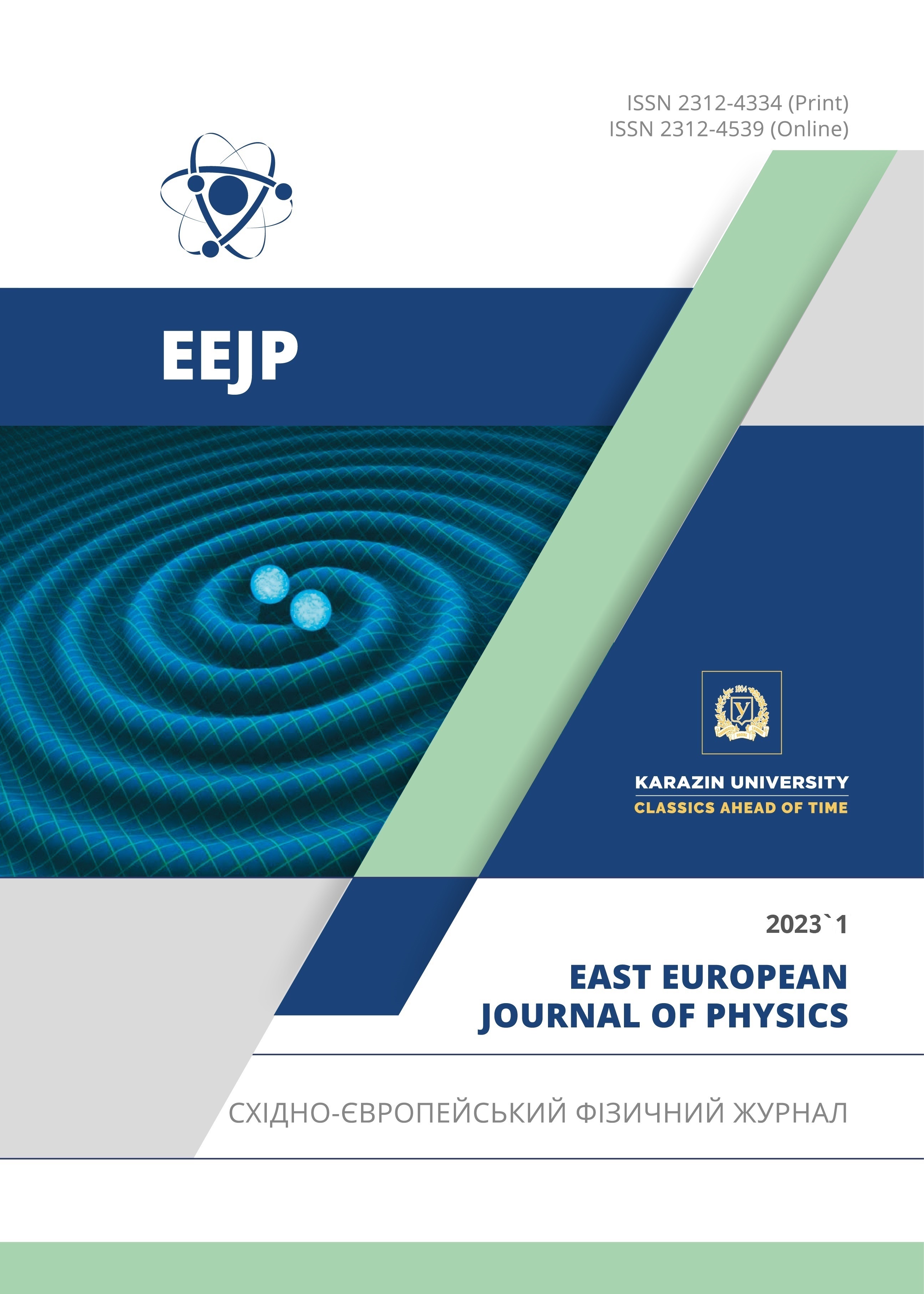A Qualitative Theoretical Study of Inorganic HTM-Free RbGeI3 Based Perovskite Solar Cells Using SCAPS 1D as a Pathway Towards 3.601% Efficiency
Abstract
The presence of toxic lead in perovskite solar cells has hindered its commercial viability. In this present work, a mesoscopic inorganic lead-free perovskite solar cells based on RbGeI3 was proposed and implemented using SCAPs simulation tool. The effect of electron transport material (ETM) and Absorber thickness were analyzed. When the device was first simulated, its power conversion efficiency (PCE), fill factor (FF), current density (Jsc), and open circuit voltage (Voc) all reached values of 3.584% for PCE, 48.477% for FF, 25.385 mA/cm2 for Jsc, and 0.291 V for Voc. When the ETM and absorber are at their ideal thicknesses of 0.08 and 0.40, the development of efficiency becomes stable. Using the aforementioned parameters, the optimized PSC device produced the following values: PCE = 3.601%, Jsc = 25.386 mA/cm2, Voc = 0.291 V, and FF = 48.637%. The PCE improvement over the basic device without optimization is around 1.01 times. The findings indicate that perovskite solar cell lacking HTM has a substantial capacity to absorb photon energy and produce electrons. It has also shown how to create environmentally clean and economically viable technology.
Downloads
References
E. Danladi, M. Kashif, A. Ichoja, and B.B. Ayiya, Transactions of Tianjin University, 28(5), (2022). https://doi.org/10.1007/s12209-022-00343-w
E. Danladi, M. Kashif, T.O Daniel, C.U. Achem, M. Alpha, and M. Gyan, East European Journal of Physics, 3, 19 (2022). https://doi.org/10.26565/2312-4334-2022-3-03
Z. Qu, F. Ma, Y. Zhao, X. Chu, S. Yu, and J. You, Chinese Physics Letters, 38, 107801 (2021). https://doi.org/10.1088/0256-307X/38/10/107801
A. Kojima, K. Teshima, Y. Shirai, and T. Miyasaka, Journal of American Chemical Society, 131, 6050 (2009). https://doi.org/10.1021/ja809598r
G. Pindolia, S.M. Shinde, P.K. Jha, Solar Energy, 236, 802 (2022). https://doi.org/10.1016/j.solener.2022.03.053
J. Wu, Y. Li, Y. Li, W. Xie, J. Shi, D. Li, S. Cheng, and Q. Meng, Journal of Materials Chemistry A, 9, 6382 (2021). https://doi.org/10.1039/D0TA12046D
J.J. Yoo, G. Seo, M.R. Chua, T.G. Park, Y. Lu, F. Rotermund, Y.K. Kim, et al., Nature, 590(7847), 587 (2021). https://doi.org/10.1038/s41586-021-03285-w
W. Ke, and M.G. Kanatzidis, Nature Communications, 10, 965 (2019). https://doi.org/10.1038/s41467-019-08918-3
N.K. Noel, S.D. Stranks, A. Abate, C. Wehrenfennig, S. Guarnera, A.A. Haghighirad, A. Sadhanala, G.E. Eperon, S.K. Pathak, M.B. Johnston, A. Petrozza, L.M. Herz, and H.J. Snaith, Energy & Environmental Science, 7, 3061 (2014). https://doi.org/10.1039/C4EE01076K
D. Saikia, J. Bera, A. Betal, and S. Sahu, Optical Materials, 123, 111839 (2022). https://doi.org/10.1016/j.optmat.2021.111839
T. Krishnamoorthy, H. Ding, C. Yan, W.L. Leong, T. Baikie, Z. Zhang, M. Sherburne, S. Li, M. Asta, N. Mathews, and S.G. Mhaisalkar, Journal of Materials Chemistry A, 3, 23829 (2015). https://doi.org/10.1039/C5TA05741H
D.K. Jayan, and V. Sebastian, Materials Today Communications, 28, 102650 (2021). https://doi.org/10.1016/j.mtcomm.2021.102650
M.G. Ju, M. Chen, Y. Zhou, J. Dai, L. Ma, N.P. Padture, and X.C. Zeng, Joule, 2, 1231 (2018). https://www.cell.com/joule/pdf/S2542-4351(18)30187-9.pdf
T. Leijtens, G.E. Eperon, N.K. Noel, S.N. Habisreutinger, A. Petrozza, and H.J. Snaith, Advanced Energy Materials, 5(20), 1500963 (2015). https://doi.org/10.1002/aenm.201500963
T.P.I. Saragi, T. Spehr, A. Siebert, T. Fuhrmann-Lieker, and J. Salbeck, Chemical Reviews, 107, 1011 (2007). https://doi.org/10.1021/cr0501341
J.M. Tour, R. Wu, and J.S. Schumm, Journal of the American Chemical Society, 112, 5662 (1990). https://doi.org/10.1021/ja00170a053
A.F. Akbulatov, L.A. Frolova, M.P. Griffin, I.R. Gearba, A. Dolocan, D.A. Vanden Bout, S. Tsarev, E.A. Katz, A.F. Shestakov, K.J. Stevenson, and P.A. Troshin, Advanced Energy Materials, 7, 1700476 (2017). https://doi.org/10.1002/aenm.201700476
Z. Hawash, L.K. Ono, S.R. Raga, M.V. Lee, and Y. Qi, Chemistry of Materials, 27, 562 (2015). https://doi.org/10.1021/cm504022q
A.K. Jena, Y. Numata, M. Ikegami, and T. Miyasaka, Journal of Materials Chemistry A, 6, 2219 (2018). https://doi.org/10.1039/C7TA07674F
K. Norrman, M.V. Madsen, S.A. Gevorgyan, and F.C. Krebs, Journal of the American Chemical Society, 132, 16883 (2010). https://doi.org/10.1021/ja106299g
L. Etgar, P. Gao Z. Xue, Q. Peng, A.K. Chandiran, B. Liu, M.K. Nazeeruddin, and M. Gratzel, Journal of the American Chemical Society, 134(42), 17396 (2012). https://doi.org/10.1021/ja307789s
M.O. Abdulmalik, E. Danladi, R.C. Obasi, P.M. Gyuk, F.U. Salifu, S. Magaji, A.C. Egbugha, and D. Thomas, East European Journal of Physics, 4, 125 (2022). https://periodicals.karazin.ua/eejp/article/view/20949
J. Barb´e, M.L. Tietze, M. Neophytou, B. Murali, E. Alarousu, A. el Labban, M. Abulikemu, W. Yue, O.F. Mohammed, I. McCulloch, A. Amassian, and S. del Gobbo, ACS Applied Materials Interfaces, 9, 11828 (2017). https://doi.org/10.1021/acsami.6b13675
S. Ahmed, F. Jannat, M.A.K. Khan, and M.A. Alim, Optik, 225, 165765 (2021). https://doi.org/10.1016/j.ijleo.2020.165765
Copyright (c) 2023 Mary T. Ekwu, Eli Danladi, Nicholas N. Tasie, Idoko S. Haruna, Osaretin E. Okoro, Philibus M. Gyuk, Olayinka M. Jimoh, Rita C. Obasi

This work is licensed under a Creative Commons Attribution 4.0 International License.
Authors who publish with this journal agree to the following terms:
- Authors retain copyright and grant the journal right of first publication with the work simultaneously licensed under a Creative Commons Attribution License that allows others to share the work with an acknowledgment of the work's authorship and initial publication in this journal.
- Authors are able to enter into separate, additional contractual arrangements for the non-exclusive distribution of the journal's published version of the work (e.g., post it to an institutional repository or publish it in a book), with an acknowledgment of its initial publication in this journal.
- Authors are permitted and encouraged to post their work online (e.g., in institutional repositories or on their website) prior to and during the submission process, as it can lead to productive exchanges, as well as earlier and greater citation of published work (See The Effect of Open Access).








